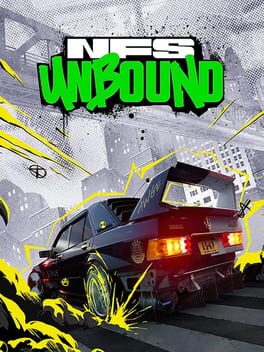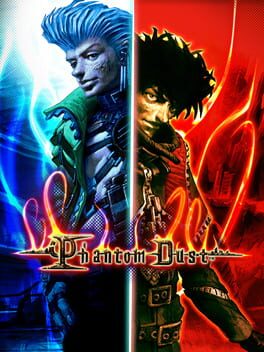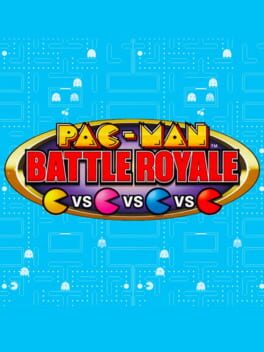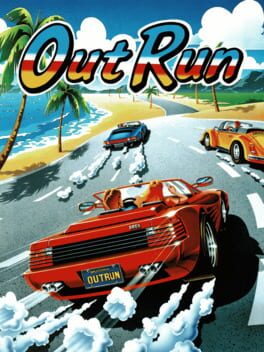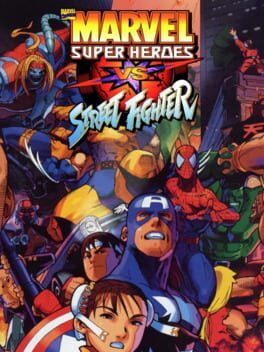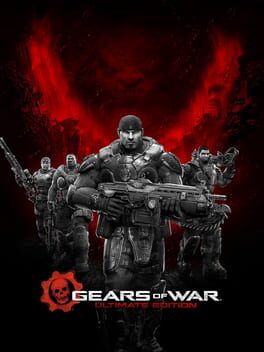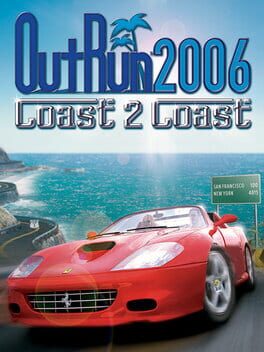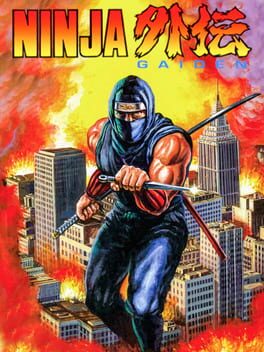ogremode
Dipped into trial. Drifting model doesn't feel great. Can't remap controls, and not going to retrain my brain to gearshift with bumpers. I like the art style and the characters/story really have some kind of soul to them, especially after playing Forza Horizon 5. Another game like Gotham Knights (and maybe Deathloop) with an interesting take on a structured day/night game cycle. Build "heat" during the day by taking on races/activities to earn money, which makes night races more difficult, but you can't bank the money until after completing the night section.
2017
2017
1986
Played one of the standing cabinets. Perfect arcade driving game, the machines are great. You got your pedals, your gear shift (in either high or low). There's major tension in knowing when to downshift so you can control your car in the corners while still maintaining speed. Crashes are punishing—you basically can't have a single screw-up if you want to get to the next goal before your time limit is up. As an arcade game it's fine, though it makes the releases at home feel overly punishing. And it's such a beautiful looking game.
First time replaying since I played the original on Xbox 360. It might be because I just played Metal Gear Solid, but there's a surprising amount of Metal Gear Solid here—if Metal Gear Solid is a spy movie, Gears of War is the dumbest military science-fiction movie of all time. Everyone looks stupid and they are stupid. Marcus Fenix, like Solid Snake, is a Snake Plissken riff, the badass expert brought in for one last mission, except he wears a doo-rag and and goes 'Oh yeah!' whenever you get the reload bonus and he praises the player with a satisfying "Nice" when you land a head shot.
Gears of War is an extremely fun sanding down of Resident Evil 4's peculiarities into the commercially perfect mass market third-person shooter. It's smooth, designed to be popular through its difficulty. Because the enemies, orcs with guns, are good at shooting you when you're out of cover, the player must thoughtfully pilot Fenix around the battlefield from waist-high fence to walls of sandbags to round planters. You will naturally find yourself flanking and searching for more interesting positions. There are only a handful of enemy types, boiling down to a low HP rushing enemy, a mid HP shooting enemy type, and the high HP explosive enemy type, all of which pressure you and your position in their respective ways. The snap-to-cover system supporting all this is a lot fun and far less frustrating than so many of its imitators. (I loved triggering the action as far away as possible and watching Marcus Fenix slide across the ground into position like a vampire.) In the best levels, you can almost exclusively advance on enemies snapping from cover to cover; it makes me wonder what a game would look like that restricted your movement entirely to those choices. Besides the shooting and the moving, there's the added layer of the reload mini-game, where if you press the reload button a second time while a slider is in an optimal position you get a damage bonus and free rounds. Nailing this feels great, and failing feels like a real fuck-up; it adds a special element of risk and reward to every battle.
However, this beautiful loop is held back by long sequences of levels that fail to highlight the game's strengths—it often feels like there's either not enough enemies or they're too spread out. The game becomes a lot less fun when you have to go hunting for the last few mobs so you can take them out so you can activate the stupid cut scenes. As well, it can be hard to get a handle on the camera in tight corridors, making handling the rushing enemy types a real pain. One way the game likes to add pressure is to send some melee guys at you to drive you out of cover, but due to how close the camera is on Fenix I had a lot of trouble staying on top of where they were coming from, and it led to some annoying deaths. At it's best, Gears of War is a blast, but it can also be somewhat dull.
Gears of War is an extremely fun sanding down of Resident Evil 4's peculiarities into the commercially perfect mass market third-person shooter. It's smooth, designed to be popular through its difficulty. Because the enemies, orcs with guns, are good at shooting you when you're out of cover, the player must thoughtfully pilot Fenix around the battlefield from waist-high fence to walls of sandbags to round planters. You will naturally find yourself flanking and searching for more interesting positions. There are only a handful of enemy types, boiling down to a low HP rushing enemy, a mid HP shooting enemy type, and the high HP explosive enemy type, all of which pressure you and your position in their respective ways. The snap-to-cover system supporting all this is a lot fun and far less frustrating than so many of its imitators. (I loved triggering the action as far away as possible and watching Marcus Fenix slide across the ground into position like a vampire.) In the best levels, you can almost exclusively advance on enemies snapping from cover to cover; it makes me wonder what a game would look like that restricted your movement entirely to those choices. Besides the shooting and the moving, there's the added layer of the reload mini-game, where if you press the reload button a second time while a slider is in an optimal position you get a damage bonus and free rounds. Nailing this feels great, and failing feels like a real fuck-up; it adds a special element of risk and reward to every battle.
However, this beautiful loop is held back by long sequences of levels that fail to highlight the game's strengths—it often feels like there's either not enough enemies or they're too spread out. The game becomes a lot less fun when you have to go hunting for the last few mobs so you can take them out so you can activate the stupid cut scenes. As well, it can be hard to get a handle on the camera in tight corridors, making handling the rushing enemy types a real pain. One way the game likes to add pressure is to send some melee guys at you to drive you out of cover, but due to how close the camera is on Fenix I had a lot of trouble staying on top of where they were coming from, and it led to some annoying deaths. At it's best, Gears of War is a blast, but it can also be somewhat dull.
2022
Signalis is the debut production by rose-engine, a two-person team made up of Barbara Wittmann and Yuri Stern. This is a strong survival horror action game. There's a mechanical emphasis on scarcity, on being thoughtful with your actions. Every attack costs ammunition of some kind, and the game doesn't dole out enough ammunition for you to ever feel too comfortable for too long. As well, your character can only carry six items. There's even an in-fiction reason for it—there's a somewhat spiritual tenet of the culture called The Rule of Six. As you continue to play the game, you learn that having certain items can be dangerous for the androids, in that they may develop problematic, rebellious personalities if they interact with certain ideas or objects; the Rule of Six, which forces you to carefully balance the weapons you're carrying (each taking one slot), the ammunition types (another slot), special items, or keys, while leaving room for pick-ups you might encounter in the world, is a means of oppression, and you feel it. In fact, my only major problem with this game was the number of times I had to backtrack to pick up items or bring the rest of the keys to a door, since some doors can require six keys. This limitation, like the scarce ammo and health drops, successfully evoke the mood its trying to establish.
The art and narrative design of Signalis recalls a lot of other games—the game is honestly homage heavy, which I don't mind, but it might bug others. I might not mind it because I've also been inspired by so much of the same stuff.
The idea of the diametrical replikant/gestalt is straight out of the replicant/gestalts in Nier: Replicant, and the way there is an attempt to manage and control the replikants from developing personalities, and the way similar personalities develop for similar robots regardless of their station, is very Nier: Automata. The first wall safe combination includes the numbers 0451, an homage to the Looking Glass/Ion Storm games. (When I got to this safe I actually tried 0451 to open it, which I always do, but it didn't work; I felt really smart when I completed the puzzle to get the code and it had 0451 in there.) Plugging the various keys into the doors is reminiscent of the colored plates puzzle from Silent Hill, and in general the puzzles recall the first three Resident Evil and Silent Hill games. (And you're constantly jumping down or crawling through holes, like in Silent Hill.) I was also reminded of Control a few times—there's the censorship of certain key-words, and the design of the mine level reminded me a lot of Control's Black Rock Quarry. There's a lot of anime influence. The character designs are reminiscent of the anime Ergo Proxy and Tsutomu Nihei's manga BLAME!, or GANTZ. There's an unmistakable Neon Genesis Evangelion influence in the way the story develops towards its emotionally driven cosmic climax; there's also a weird fiction (my favorite kind) influence in the story: you find a copy of The King In Yellow in the game, and certain places reminded me a lot of what I imagined when reading The Fisherman by John Langan. The HUD and menus also seem inspired by Evangelion. There's an industrial looking funicular elevator that evokes the ones in Evangelion, Akira, and Metal Gear Solid. And of course there's a lot of Alien in the industrial spaceship and planet base designs. The PS1 style models, where the faces are fragmented into polygons evoking the ideas of a face, are used for cut scenes, and are reminiscent of Metal Gear Solid and Silent Hill. The game also references The Isle of the Dead), a series of paintings done by Arnold Böcklin who created many different versions of it, and which is homaged often in art, from artists like Salvador Dali to movies like Alien: Covenant.
But the game isn't just its influences. It's effortlessly stylish. The use of German in HUDs and cut-scenes are just cool; the cut-scenes themselves have a rapid editing and strange style to them, cutting between anime style drawn close-ups of characters or objects, text, tech HUDs. The game enters first person in certain spaces, and there are full first-person interludes that gives the game a nice pace. I dug this game, and I'm excited to see where rose-engine goes next.
The art and narrative design of Signalis recalls a lot of other games—the game is honestly homage heavy, which I don't mind, but it might bug others. I might not mind it because I've also been inspired by so much of the same stuff.
The idea of the diametrical replikant/gestalt is straight out of the replicant/gestalts in Nier: Replicant, and the way there is an attempt to manage and control the replikants from developing personalities, and the way similar personalities develop for similar robots regardless of their station, is very Nier: Automata. The first wall safe combination includes the numbers 0451, an homage to the Looking Glass/Ion Storm games. (When I got to this safe I actually tried 0451 to open it, which I always do, but it didn't work; I felt really smart when I completed the puzzle to get the code and it had 0451 in there.) Plugging the various keys into the doors is reminiscent of the colored plates puzzle from Silent Hill, and in general the puzzles recall the first three Resident Evil and Silent Hill games. (And you're constantly jumping down or crawling through holes, like in Silent Hill.) I was also reminded of Control a few times—there's the censorship of certain key-words, and the design of the mine level reminded me a lot of Control's Black Rock Quarry. There's a lot of anime influence. The character designs are reminiscent of the anime Ergo Proxy and Tsutomu Nihei's manga BLAME!, or GANTZ. There's an unmistakable Neon Genesis Evangelion influence in the way the story develops towards its emotionally driven cosmic climax; there's also a weird fiction (my favorite kind) influence in the story: you find a copy of The King In Yellow in the game, and certain places reminded me a lot of what I imagined when reading The Fisherman by John Langan. The HUD and menus also seem inspired by Evangelion. There's an industrial looking funicular elevator that evokes the ones in Evangelion, Akira, and Metal Gear Solid. And of course there's a lot of Alien in the industrial spaceship and planet base designs. The PS1 style models, where the faces are fragmented into polygons evoking the ideas of a face, are used for cut scenes, and are reminiscent of Metal Gear Solid and Silent Hill. The game also references The Isle of the Dead), a series of paintings done by Arnold Böcklin who created many different versions of it, and which is homaged often in art, from artists like Salvador Dali to movies like Alien: Covenant.
But the game isn't just its influences. It's effortlessly stylish. The use of German in HUDs and cut-scenes are just cool; the cut-scenes themselves have a rapid editing and strange style to them, cutting between anime style drawn close-ups of characters or objects, text, tech HUDs. The game enters first person in certain spaces, and there are full first-person interludes that gives the game a nice pace. I dug this game, and I'm excited to see where rose-engine goes next.
2022
Pentiment is the new narrative game with some RPG elements directed by Josh Sawyer, who famously directed Fallout: New Vegas. Set in 16th century Bavaria, you play as Andreas Maler, an apprentice illuminator and painter who splits his time working in the abbey on the book projects with monks and on his masterpiece, an art piece that he can show to potential clients once he leaves the abbey. After a murder, you investigate various people in the town looking for whoever is most likely to have the motive. Along the way you get to spend a lot of time with well-written, interesting characters, developing your own character along the way. Many choices are tracked and influence your options later, and you will feel ashamed of your words and deeds.
I really loved this game. Like Disco Elysium, the RPG elements serve more as the characterization of your protagonist than anything else. While different backgrounds will give you different ranges of responses in certain situations, these are never necessarily better or more preferable than other dialogue, and in fact may get you less preferable outcomes.
The game has a lot of style. The character and background artwork is inspired by illumination mansucripts, and character dialogue text is rendered depending on their backgrounds—printers get an animation that evoke printing, the monks that work in the scriptorium all write in beautiful script, and peasants and middle-class characters write in their own scripts. As well, the writing itself takes longer or shorter depending on the character. A peasant may write their script slow, but a monk with a lot of scriptorium experience will write in their script much faster.
The events and options you have depend on the section of time you're in. For example, you will do an event which will pass the time from the morning to lunch time, then more options open during lunch time. You end lunch by having a meal with someone, then the next time slot opens up and so on. The meals are used to develop characters—you often have a lot of options with who to eat with, and what they eat is dependent on their class. Monks may have a lot of wine and fish, while peasants will share small morsels almonds and cheese and bread with you.
I flew through the game and really loved the time I got to spend with the characters; as the narrative evolved, I came to care a lot for them, and felt genuine emotions about the story and my part in them. It's a real achievement.
I really loved this game. Like Disco Elysium, the RPG elements serve more as the characterization of your protagonist than anything else. While different backgrounds will give you different ranges of responses in certain situations, these are never necessarily better or more preferable than other dialogue, and in fact may get you less preferable outcomes.
The game has a lot of style. The character and background artwork is inspired by illumination mansucripts, and character dialogue text is rendered depending on their backgrounds—printers get an animation that evoke printing, the monks that work in the scriptorium all write in beautiful script, and peasants and middle-class characters write in their own scripts. As well, the writing itself takes longer or shorter depending on the character. A peasant may write their script slow, but a monk with a lot of scriptorium experience will write in their script much faster.
The events and options you have depend on the section of time you're in. For example, you will do an event which will pass the time from the morning to lunch time, then more options open during lunch time. You end lunch by having a meal with someone, then the next time slot opens up and so on. The meals are used to develop characters—you often have a lot of options with who to eat with, and what they eat is dependent on their class. Monks may have a lot of wine and fish, while peasants will share small morsels almonds and cheese and bread with you.
I flew through the game and really loved the time I got to spend with the characters; as the narrative evolved, I came to care a lot for them, and felt genuine emotions about the story and my part in them. It's a real achievement.
2022
This is the first game I've played directed by Sam Barlow. I had a good time exploring this game. The story itself is interesting enough, but it does feel a lot like a guy who is really into David Lynch decidedly making something in the Lynch vein but getting too into the details of the supernatural stuff; which is to say the story works on its own, but that it invites comparisons it just can't win. Granted, that's true for most narrative games. Disco Elysium isn't much different, or necessarily better, than dozens of detective novels; Pentiment is a hair away from being an adaptation of Umberto Eco's The Name of the Rose. That doesn't take anything away from them being excellent games.
The reason we go to narrative games is because they are games, not because of the narrative, and the game to this one is fascinating. You navigate through the clips—and so, through the story—by clicking on an object on the screen: an actor, a painting, a fruit, a light; there's a shocking amount of variety on what you can click on to move forward. You are then sent to a different clip through a match-cut. You click on a candle in one scene and then are sent to a candle in a different scene; there's a digital zoom out from the candle in the new scene, and then the clip continues to play from there. You learn eventually that you should rewind to the beginning of the clip to see the whole thing. Your navigation through the clips is semi-random, meaning that you will bounce around until you're sent to specific clips at certain times to further the main story. The journey through the story is unique for each play through; it's a radical version of post-modern, non-linear story-telling, like if the different stories in Pulp Fiction were twice as long and played on shuffle. The narrative peels open this way, and that itself is fascinating alone.
It isn't just that you jump to a scene watch it, pick something, and then watch another scene either. You can't really put the controller down and look at your phone; you're forced to pay attention to the narrative. In the age of streaming, this is an interesting innovation in itself (and maybe streaming shows would be better if the creators knew for certain you would pay total attention to them). You can't put down the controller because there are secret clips. Your controller vibrates, there's usually a distinctive eerie audio cue, and you have to manually rewind at the correct speed to push the secret scene open. If you miss the cue (or, like me, wonder "what the hell was that" when it happens the first couple times) the scenes with secret scenes in them will have a glowing background on the clip view. The speed you have to rewind is different usually; sometimes you have to turn your stick slowly, sometimes it helps to fast rewind. There isn't a lot of feedback for this action though, and for some scenes I had a lot of trouble getting them to play. This difficulty didn't seem contingent on the content of the scene either; it wasn't necessarily that the scenes that were harder to open had more rewarding story or character information. I could have used some stronger feedback, but that's the only major criticism I had to the game-play.
As to the story itself and the various films, I was never super into it. Like I said before, it invites comparisons it can't handle, and the production of everything is way too clean, so it comes off ahistorical looking, something that won't really bother you if you're not like me. There's a layer of theatrical unreality that doesn't work in its favor; the movie scenes don't feel like scenes shot for a movie, but scenes shot for a fake movie video game. But it's fun and can be interesting; the novelty was enough to drive me forward with this one. I was left pretty interested in checking out Barlow's other games.
The reason we go to narrative games is because they are games, not because of the narrative, and the game to this one is fascinating. You navigate through the clips—and so, through the story—by clicking on an object on the screen: an actor, a painting, a fruit, a light; there's a shocking amount of variety on what you can click on to move forward. You are then sent to a different clip through a match-cut. You click on a candle in one scene and then are sent to a candle in a different scene; there's a digital zoom out from the candle in the new scene, and then the clip continues to play from there. You learn eventually that you should rewind to the beginning of the clip to see the whole thing. Your navigation through the clips is semi-random, meaning that you will bounce around until you're sent to specific clips at certain times to further the main story. The journey through the story is unique for each play through; it's a radical version of post-modern, non-linear story-telling, like if the different stories in Pulp Fiction were twice as long and played on shuffle. The narrative peels open this way, and that itself is fascinating alone.
It isn't just that you jump to a scene watch it, pick something, and then watch another scene either. You can't really put the controller down and look at your phone; you're forced to pay attention to the narrative. In the age of streaming, this is an interesting innovation in itself (and maybe streaming shows would be better if the creators knew for certain you would pay total attention to them). You can't put down the controller because there are secret clips. Your controller vibrates, there's usually a distinctive eerie audio cue, and you have to manually rewind at the correct speed to push the secret scene open. If you miss the cue (or, like me, wonder "what the hell was that" when it happens the first couple times) the scenes with secret scenes in them will have a glowing background on the clip view. The speed you have to rewind is different usually; sometimes you have to turn your stick slowly, sometimes it helps to fast rewind. There isn't a lot of feedback for this action though, and for some scenes I had a lot of trouble getting them to play. This difficulty didn't seem contingent on the content of the scene either; it wasn't necessarily that the scenes that were harder to open had more rewarding story or character information. I could have used some stronger feedback, but that's the only major criticism I had to the game-play.
As to the story itself and the various films, I was never super into it. Like I said before, it invites comparisons it can't handle, and the production of everything is way too clean, so it comes off ahistorical looking, something that won't really bother you if you're not like me. There's a layer of theatrical unreality that doesn't work in its favor; the movie scenes don't feel like scenes shot for a movie, but scenes shot for a fake movie video game. But it's fun and can be interesting; the novelty was enough to drive me forward with this one. I was left pretty interested in checking out Barlow's other games.
Elevator Action Returns - S-Tribute is a rerelease of the Taito masterpiece for modern platforms, specifically of the Sega Saturn version, with the usual bells and whistles of emulated game releases like this. There's quick saves so you can put a run down and return to it later, a "slow mode" that can be activated at any time to makes the game a little easier, there's a difficulty setting, options for infinite or limited credits, and buttons are all remappable. But the release could be a little better. There's none of the fun behind the scenes stuff like concept art or box art galleries like you'll find in the Megaman or Castlevania Collections. And unfortunately there's no online version, so you cannot play with friends online, but you can do two player couch co-op.
Still, Elevator Action Returns is one of the beautiful action arcade games. It improves on the original by bringing using mechanics from Namco's Rolling Thunder, the side-scrolling arcade shooting/cover game. Enemies spawn from doors. Both you and enemies can crouch; weapons are fired on either the high or low axis, and you can avoid damage by ducking under or jumping over bullets, or taking cover (though most cover will degrade after a few hits). The goal of the game is to fight your way to every red door in a level, then get to the end of the level to escape. There are security cameras which, if you don't shoot in time, will spawn more enemies. The game will take about an hour or so per play-through, with infinite credits, depending on how often you die, but it's such a blast all the way through.
You can play as one of three characters, and swap between them on the fly when you run out of lives and have to put in a credit. There's Kart Bradfield, who is the most agile and has a hand grenade as his subweapon. There's Edie Burret, who has the fire bomb subweapon and more importantly can fire bullets very quickly. Then there's Jad the Taff, who's very tough and has a proximity bomb subweapon.
There are a handful of set-pieces in each level—exploding planes your character escapes from, collapsing buildings, and so on, which break up the games pace a bit and are always cool as hell and well-animated. The art style is also just sick as hell 90s anime inspired pixel art. It's a real blast to play through, and I hope one day I get to play it on a cabinet.
GOTY 2022.
Still, Elevator Action Returns is one of the beautiful action arcade games. It improves on the original by bringing using mechanics from Namco's Rolling Thunder, the side-scrolling arcade shooting/cover game. Enemies spawn from doors. Both you and enemies can crouch; weapons are fired on either the high or low axis, and you can avoid damage by ducking under or jumping over bullets, or taking cover (though most cover will degrade after a few hits). The goal of the game is to fight your way to every red door in a level, then get to the end of the level to escape. There are security cameras which, if you don't shoot in time, will spawn more enemies. The game will take about an hour or so per play-through, with infinite credits, depending on how often you die, but it's such a blast all the way through.
You can play as one of three characters, and swap between them on the fly when you run out of lives and have to put in a credit. There's Kart Bradfield, who is the most agile and has a hand grenade as his subweapon. There's Edie Burret, who has the fire bomb subweapon and more importantly can fire bullets very quickly. Then there's Jad the Taff, who's very tough and has a proximity bomb subweapon.
There are a handful of set-pieces in each level—exploding planes your character escapes from, collapsing buildings, and so on, which break up the games pace a bit and are always cool as hell and well-animated. The art style is also just sick as hell 90s anime inspired pixel art. It's a real blast to play through, and I hope one day I get to play it on a cabinet.
GOTY 2022.
Install instructions at the end of this review...
The sequel to Outrun vastly improves upon the original game by adding a handful of empowering mechanics, and adding layers to the original vision. This can be annoying in bad games, but Yu Suzuki and team made something sparkling and beautiful here.
Outrun 2 gives you five gears to work up through. You'll rarely want to use anything but the last two. The speedometer is drawn in the right-hand corner, and every car has a different optimal place to upshift. When the space behind the needle is white, you're in a good place with your gear and speed. The starter cars have yellow spots on the speedometer that signal you should upshift, which are missing from the faster cars; you just have to time it so you upshift before your needle spills over to the red. I'm not sure if there's any mechanical bonus for upshifting while in the optimal spot, but even without that this feature brings the satisfying timing rhythm of the reloading mini-game from Gears of War.
The trick of the original Outrun is downshifting into corners so you can maintain control of the car, otherwise you will slide too far on either side off the road and into obstacles. When you downshift on the corners here, your car slides into a the most satisfying drift ever made. To me it feels somewhere between the Mario Kart 8 drift and the manual mini-game in Tony Hawk's Pro Skater. You have to lean your analog stick left or right into the drift, and time it just right when you come out of a drift to straighten your car—you also need to remember to upshift back into a higher gear to maintain your speed. Downshifting while turning isn't the only way to enter a drift—you can use your brake too—but it's the way that felt the most natural and optimal to me.
Drafting is as important as drifting. I smiled like a baby when I drove behind another car and not only got a slipstream effect, but a big SLIPSTREAM title in the middle of my screen like a trick from Tony Hawk Pro Skater, and when my Dino 246 GTS zoomed quickly behind the other car, sling-shotting around a DeVille with ease, it felt amazing. Unlike other arcade racers, there aren't dedicated boost spots on the road or nitrous you can kick off: the other cars on the road are your speed boosts. I've never played another game where the slipstream effect, a real-life racing technique, is this useful (or fun to use). There is also some risk-reward to this mechanic. Since you're going so fast, it's easy to smack into the back of the car that's pulling you forward. This isn't an unrecoverable moment in a race, so long as it happens early enough, and it doesn't mean you won't reach the goal in time in Outrun mode—you're afforded a few mistakes, but you will cut it close if you're not fast. Besides killing the momentum, what it does do is push the car you hit in front of you. There is no pit maneuver or side-swipe mechanic to take out the competition—if you hit the car in front of you, you are giving it a boost of their own. It's a beautiful solution to enforcing race etiquette afforded purely by its arcade style.
The slipstream effect is helpful in the rote races to speed around your rivals, but it is delightful in the Outrun mode, which is where you should be spending most of your time. You aren't racing other drivers through the five (or fifteen) locations; you're just trying to get to the end before the timer ticks down. And since you're in a hurry, of course there's traffic. But the traffic is an opportunity to get ahead of it and impress your girlfriend. While you're weaving through it like the most annoying 24 year old on the highway, your girlfriend asks, in a voice that's sweet yet coy, "How far are you going to take me?" The driving in Outrun 2006: Coast 2 Coast feels so visceral and satisfying, so good, that it's impossible to deny its sensual effect. I can't remember the last time I fell harder in love with a game than this recent tryst with Outrun 2006: Coast 2 Coast. I've played it every day since I started playing it; I only want to play more of it.
There are certain games I like to have on every PC I use, and this has quickly become one of those. I've written install instructions below, in case I forget.
---
Download Outrun 2006: Coast 2 Coast for PC from MyAbandonware dot com; use the MagiPack repack, which comes with the FXT mod pre-installed. After installing the MagiPack repack, navigate to the folder you installed it on your hard drive and run the FXTConfig.exe executable as admin. If you are installing this on a PC that hasn't had many games installed on it, you will need to install the Visual C++ Redistributable for Visual Studio 2015 x86 version. In the FXT mod settings, turn off XInput, or rumble might not work. After opening the game and saving your license, open up the license settings, set your name to ENTIRETY, then back out without saving to unlock all cars and tracks.
The sequel to Outrun vastly improves upon the original game by adding a handful of empowering mechanics, and adding layers to the original vision. This can be annoying in bad games, but Yu Suzuki and team made something sparkling and beautiful here.
Outrun 2 gives you five gears to work up through. You'll rarely want to use anything but the last two. The speedometer is drawn in the right-hand corner, and every car has a different optimal place to upshift. When the space behind the needle is white, you're in a good place with your gear and speed. The starter cars have yellow spots on the speedometer that signal you should upshift, which are missing from the faster cars; you just have to time it so you upshift before your needle spills over to the red. I'm not sure if there's any mechanical bonus for upshifting while in the optimal spot, but even without that this feature brings the satisfying timing rhythm of the reloading mini-game from Gears of War.
The trick of the original Outrun is downshifting into corners so you can maintain control of the car, otherwise you will slide too far on either side off the road and into obstacles. When you downshift on the corners here, your car slides into a the most satisfying drift ever made. To me it feels somewhere between the Mario Kart 8 drift and the manual mini-game in Tony Hawk's Pro Skater. You have to lean your analog stick left or right into the drift, and time it just right when you come out of a drift to straighten your car—you also need to remember to upshift back into a higher gear to maintain your speed. Downshifting while turning isn't the only way to enter a drift—you can use your brake too—but it's the way that felt the most natural and optimal to me.
Drafting is as important as drifting. I smiled like a baby when I drove behind another car and not only got a slipstream effect, but a big SLIPSTREAM title in the middle of my screen like a trick from Tony Hawk Pro Skater, and when my Dino 246 GTS zoomed quickly behind the other car, sling-shotting around a DeVille with ease, it felt amazing. Unlike other arcade racers, there aren't dedicated boost spots on the road or nitrous you can kick off: the other cars on the road are your speed boosts. I've never played another game where the slipstream effect, a real-life racing technique, is this useful (or fun to use). There is also some risk-reward to this mechanic. Since you're going so fast, it's easy to smack into the back of the car that's pulling you forward. This isn't an unrecoverable moment in a race, so long as it happens early enough, and it doesn't mean you won't reach the goal in time in Outrun mode—you're afforded a few mistakes, but you will cut it close if you're not fast. Besides killing the momentum, what it does do is push the car you hit in front of you. There is no pit maneuver or side-swipe mechanic to take out the competition—if you hit the car in front of you, you are giving it a boost of their own. It's a beautiful solution to enforcing race etiquette afforded purely by its arcade style.
The slipstream effect is helpful in the rote races to speed around your rivals, but it is delightful in the Outrun mode, which is where you should be spending most of your time. You aren't racing other drivers through the five (or fifteen) locations; you're just trying to get to the end before the timer ticks down. And since you're in a hurry, of course there's traffic. But the traffic is an opportunity to get ahead of it and impress your girlfriend. While you're weaving through it like the most annoying 24 year old on the highway, your girlfriend asks, in a voice that's sweet yet coy, "How far are you going to take me?" The driving in Outrun 2006: Coast 2 Coast feels so visceral and satisfying, so good, that it's impossible to deny its sensual effect. I can't remember the last time I fell harder in love with a game than this recent tryst with Outrun 2006: Coast 2 Coast. I've played it every day since I started playing it; I only want to play more of it.
There are certain games I like to have on every PC I use, and this has quickly become one of those. I've written install instructions below, in case I forget.
---
Download Outrun 2006: Coast 2 Coast for PC from MyAbandonware dot com; use the MagiPack repack, which comes with the FXT mod pre-installed. After installing the MagiPack repack, navigate to the folder you installed it on your hard drive and run the FXTConfig.exe executable as admin. If you are installing this on a PC that hasn't had many games installed on it, you will need to install the Visual C++ Redistributable for Visual Studio 2015 x86 version. In the FXT mod settings, turn off XInput, or rumble might not work. After opening the game and saving your license, open up the license settings, set your name to ENTIRETY, then back out without saving to unlock all cars and tracks.
2022
1988
Ninja Gaiden can be an excellent post-Castlevania NES action game, turning up the speed just so to forge its fast identity that would carry through for decades. Where Trevor Belmont plods his way towards Dracula's castle, and his whip attacks require a comparatively long wind up, Ryu Hayabusa dashes and flips fluidly through levels and whips his katana out with lightning speed—though, crucially, not instantly. In its best moments the level design supports and drives this speed, but too often, and especially as you get deeper into the game, enemies are placed directly where you would flip into them, brutally disrupting the flow. Most of the time these obstacle enemies only spawn as you get to the edge of a platform, when, if you're playing speedily, you've already jumped, so it feels especially unfair and punishing. You're forced to pause and wait for the enemy to move over, batting away enemy hawks in the meantime; it just doesn't really feel good. But the moment to moment action outside of this is a lot of fun and feels snappy.
The bosses are more merciful experiences, tests of your patience and problem solving more than they are your pure action skills, though they can require power-ups to make them at all bearable. They're fine and satisfying, but they don't feel necessarily of one with the speed that makes the levels so fun. Looking forward to playing the sequels.
The bosses are more merciful experiences, tests of your patience and problem solving more than they are your pure action skills, though they can require power-ups to make them at all bearable. They're fine and satisfying, but they don't feel necessarily of one with the speed that makes the levels so fun. Looking forward to playing the sequels.
2006
